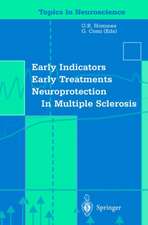Presynaptic Terminals
Editat de Sumiko Mochidaen Limba Engleză Hardback – 6 feb 2015
Neural networks transmit input and output signals of action potentials using chemical synapses. The strength of the signal from one to another neuron can be tuned by the neural signal itself as it induces Ca2+ entry and by other neurons’ signals that modify Ca2+ entry through voltage-gated Ca2+ channels at the active zone, where chemical neurotransmitters are released from synaptic vesicles via exocytosis. Synaptic vesicles are docked and primed at the active zone prior to exocytosis and are endocytosed after exocytosis for reuse at a small presynaptic terminal. Recycled vesicles are refilled with transmitters and stored for a future round of exocytosis. Thus, synaptic vesicles in presynaptic terminals go through various phases. Each vesicle phase is well orchestrated by numerous proteins and advance step-by-step with neural activities.
The fine regulations of synaptic vesicle phases by numerous proteins is an exciting subject, and systematic, well-organized explanations in this book will help the reader easily learn about complicated molecular mechanisms in presynaptic terminals.
| Toate formatele și edițiile | Preț | Express |
|---|---|---|
| Paperback (1) | 567.95 lei 38-45 zile | |
| Springer – 6 oct 2016 | 567.95 lei 38-45 zile | |
| Hardback (1) | 650.86 lei 6-8 săpt. | |
| Springer – 6 feb 2015 | 650.86 lei 6-8 săpt. |
Preț: 650.86 lei
Preț vechi: 765.72 lei
-15% Nou
Puncte Express: 976
Preț estimativ în valută:
124.55€ • 133.18$ • 103.84£
124.55€ • 133.18$ • 103.84£
Carte tipărită la comandă
Livrare economică 18 aprilie-02 mai
Preluare comenzi: 021 569.72.76
Specificații
ISBN-13: 9784431551652
ISBN-10: 4431551654
Pagini: 450
Ilustrații: XIV, 365 p. 35 illus., 33 illus. in color.
Dimensiuni: 155 x 235 x 22 mm
Greutate: 0.71 kg
Ediția:2015
Editura: Springer
Colecția Springer
Locul publicării:Tokyo, Japan
ISBN-10: 4431551654
Pagini: 450
Ilustrații: XIV, 365 p. 35 illus., 33 illus. in color.
Dimensiuni: 155 x 235 x 22 mm
Greutate: 0.71 kg
Ediția:2015
Editura: Springer
Colecția Springer
Locul publicării:Tokyo, Japan
Public țintă
ResearchCuprins
Preface.- Part 1 Overview.- 1 Overview: Presynaptic Terminal Proteins Orchestrate Stepwise Synaptic Vesicle Phases (Sumiko Mochida).- Part 2 Presynaptic Active Zone Proteins.- 2 Active Zone Assembly (Thomas Dresbach).- 3 Network of Protein-Protein Interaction at the Presynaptic Active Zone (Toshihisa Ohtsuka).- Part 3 Synaptic Vesicle Fusion.- 4 Fusion Machinery: SNARE Protein Complex (Ira Milosevic and Jakob B. Sørensen).- 5 Roles of Tomosyn in Neurotransmitter Release (Yasunori Yamamoto and Toshiaki Sakisaka).- 6 Regulation of SNAREs: Complexin (Hiroshi Tokumaru).- 7 The Synaptic Vesicle V-ATPase: A Regulatory Link Between Loading and Fusion? (Oussama El Far and Michael Seager).- 8 Ca2+ Sensors: Synaptotagmins (Tei-ichi Nishiki, Kentaro Kuroki, Toshio Masumoto, and Hideki Matsui).- 9 Regulation of Active Zone Ca2+ Channels (Karina Leal and Sumiko Mochida).- Part 4 Synaptic Vesicle Endocytosis.- 10 Endocytic Machinery at theNeuronal Synapse (Ira Milosevic).- 11 Dynamin is a Key Molecule to Decode Action Potential Firing (Shota Tanifuji and Sumiko Mochida).- Part 5 Synaptic Vesicle Refilling and Storage.- 12 Transport of Amino Acid Neurotransmitters Into Synaptic Vesicles (Shigeo Takamori).- 13 Synapsins and Synaptic Vesicle Storage (Fabrizia C. Guarnieri, Fabio Benfenati, and Flavia Valtorta).- Part 6 Synaptic Vesicle Pools.- 14 Synaptic Vesicle Pools: Classical and Emerging Roles (Sven Truckenbrodt and Silvio O. Rizzoli).- BM Index.
Textul de pe ultima copertă
This book brings together leading international experts to discuss recent advances in functional studies on key proteins and protein complexes involved in each synaptic vesicle phase. These include proteins that control the final step of neurotransmitter release, in response to a neural signal, and the first step of vesicle endocytosis, which helps maintain stable neurotransmitter release in response to unceasing neural signals arriving at presynaptic terminals.
Neural networks transmit input and output signals of action potentials using chemical synapses. The strength of the signal from one to another neuron can be tuned by the neural signal itself as it induces Ca2+ entry and by other neurons’ signals that modify Ca2+ entry through voltage-gated Ca2+ channels at the active zone, where chemical neurotransmitters are released from synaptic vesicles via exocytosis. Synaptic vesicles are docked and primed at the active zone prior to exocytosis and are endocytosed after exocytosis for reuse at a small presynaptic terminal. Recycled vesicles are refilled with transmitters and stored for a future round of exocytosis. Thus, synaptic vesicles in presynaptic terminals go through various phases. Each vesicle phase is well orchestrated by numerous proteins and advance step-by-step with neural activities.
The fine regulations of synaptic vesicle phases by numerous proteins is an exciting subject, and systematic, well-organized explanations in this book will help the reader easily learn about complicated molecular mechanisms in presynaptic terminals.
Neural networks transmit input and output signals of action potentials using chemical synapses. The strength of the signal from one to another neuron can be tuned by the neural signal itself as it induces Ca2+ entry and by other neurons’ signals that modify Ca2+ entry through voltage-gated Ca2+ channels at the active zone, where chemical neurotransmitters are released from synaptic vesicles via exocytosis. Synaptic vesicles are docked and primed at the active zone prior to exocytosis and are endocytosed after exocytosis for reuse at a small presynaptic terminal. Recycled vesicles are refilled with transmitters and stored for a future round of exocytosis. Thus, synaptic vesicles in presynaptic terminals go through various phases. Each vesicle phase is well orchestrated by numerous proteins and advance step-by-step with neural activities.
The fine regulations of synaptic vesicle phases by numerous proteins is an exciting subject, and systematic, well-organized explanations in this book will help the reader easily learn about complicated molecular mechanisms in presynaptic terminals.
Caracteristici
Includes detailed explanations of stepwise synaptic vesicle phases to help readers quickly learn about the structure and function of presynaptic terminals Focuses on unique protein complexes as a new aspect in the control of synaptic vesicles phases Provides deep insights for future study of presynaptic terminals






















